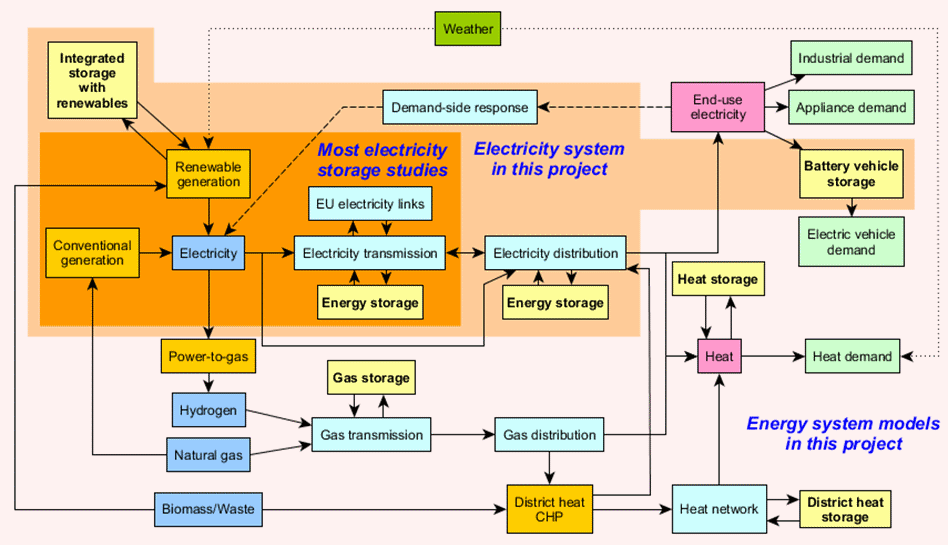About the RESTLESS project
The RESTLESS project is assessing the potential value of energy storage to the UK, as part of our transition to a low-carbon economy. The project aims to understand how novel energy storage technologies can be integrated into the UK energy system to support renewable generation in the future.
Understanding the Whole-System Value of Energy Storage
In the past, coal and nuclear plants have provided a constant "baseload" output while flexible gas and oil-fired stations have provided "flexible" generation to meet peaks.
There is strong pressure to transition to a low-carbon electricity system that avoids fossil fuels such as coal, oil and gas. Renewables such as wind turbines and solar panels generate zero-carbon electricity but their output is highly variable. Nuclear power stations provide constant but inflexible output.
As the proportion of renewables and nuclear generation increases, alternatives to the use of flexible fossil-fuelled generation as a means of balancing the electricity system will become increasingly valuable.
Numerous energy storage technologies for storing electricity are under development to meet this demand, and as the cost of storage is reduced through innovation, it is possible that they could have an important role in a low-carbon energy system. However, this depends on the costs and benefits relative to the sharing of these electricity imbalances through greater interconnection, demand-side electricity response and wider energy system storage. This project aims to understand how novel energy storage technologies might be integrated into the UK energy system in the future.
The RESTLESS project is taking a broader approach than previous projects by considering alternative energy system scenarios in which storage options are more integrated into the energy system (e.g. producing hydrogen for transport or heat for buildings), using a series of soft-linked energy and electricity system models. The diagram below compares the breadth of the energy system that tends to be examined in other projects and that is being considered in this project:

Our approach
We are examining three hypotheses:
- that a whole energy system approach to ES is necessary to fully understand how different technologies might contribute as innovation reduces costs and as the UK energy system evolves;
- that a range of technological, economic and social factors affect the value of ES, so should all be considered in energy system scenarios; and,
- that the economic value of the difference between good and bad policy decisions relating to the role of energy storage in the transition to low-carbon generation is in the order of £bns.
Details
The project research activities include:
Metrics and environmental impacts
We are developing technology-neutral metrics for energy storage technologies to inform the wider scientific community, with a particular emphasis on analysing gaps in which additional funded research and development can have the greatest impact. We are also examining the environmental impacts of energy storage technologies using LCA.
Whole system energy storage valuation
We are examining the wider system benefits of different energy storage technologies using three energy systems:
- DynEMo (Dynamic Energy Model) is a simulation model of the UK energy system with detailed weather-driven demands supplied by renewable intermittent generation, networks and energy storage, using innovative system control algorithms. The highly flexible timescales, from minutes to years, mean it is ideally placed to examine a wide range of energy storage technologies.
- UKTM-UCL is a market-based economic optimisation model that represents all UK energy flows and greenhouse gas emissions. A key feature of UKTM is the ability to simulate many different types of energy storage technologies, on inter-seasonal to intra-day timescales.
- ETM-UCL is an 11-region European energy system model, similar to UKTM, which we are using to evaluate UK–EU electricity trading through interconnections.
Electricity system valuation
We are examining the integration of energy storage technologies within the GB power system by adapting and linking our existing network models at EU and GB transmission and distribution levels, with the aim of calibrating and validating the three energy system models. We are also examining the operational impacts of energy storage, accounting for renewable spatiotemporal characteristics and interactions with gas and electricity networks.
Economic analysis and market models
We are assessing how the value of energy storage technologies can be realised through the design of electricity markets and business models. This includes exploring the opportunities for consumers to benefit by providing their own energy storage services to the electricity grid.
Public attitudes
We are examining public attitudes towards energy storage technologies and the roles that they might have in the future UK energy system. Public engagement with energy supply and demand technologies has been identified as a critical issue for the future deployment of innovative and low-carbon energy systems, but there is a significant gap in knowledge for energy storage.
Integration and scenario analysis
We will combine all of the insights from the project to identify and analyse a series of integrated future scenarios for energy storage.
Policy and research implications
We will conclude the project by making recommendations for energy policy and innovation support that will facilitate the deployment of energy storage, based on robust evidence and stakeholder engagement. Our analyses will identify the performance characteristics that are most highly valued in UK and international markets, and show which technologies may be most suitable for deployment. We will review and update the National Roadmap for Energy Storage, providing guidance to policy makers and funders on appropriate innovation support mechanisms and priority research areas.
 Close
Close

